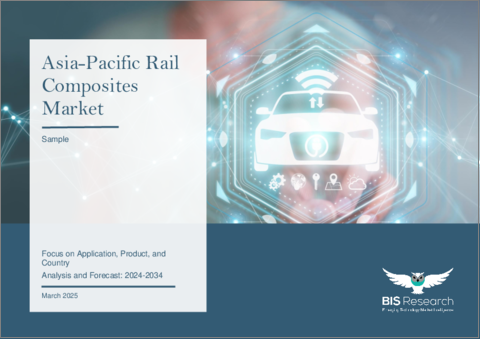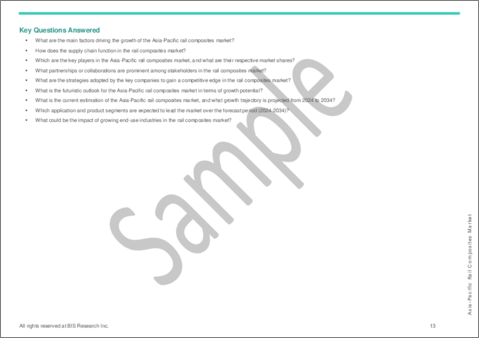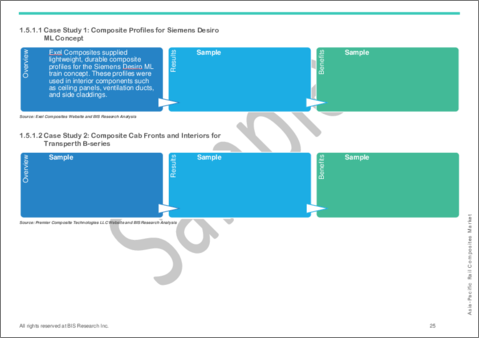|
|
市場調査レポート
商品コード
1681511
アジア太平洋の鉄道用複合材料市場:用途別、製品別、国別 - 分析と予測(2024年~2034年)Asia-Pacific Rail Composites Market: Focus on Application, Product, and Country - Analysis and Forecast, 2024-2034 |
||||||
カスタマイズ可能
|
|||||||
| アジア太平洋の鉄道用複合材料市場:用途別、製品別、国別 - 分析と予測(2024年~2034年) |
|
出版日: 2025年03月19日
発行: BIS Research
ページ情報: 英文 71 Pages
納期: 1~5営業日
|
全表示
- 概要
- 図表
- 目次
アジア太平洋の鉄道用複合材料の市場規模は、2024年の9億8,370万米ドルから2034年には18億6,610万米ドルに達し、予測期間の2024年~2034年のCAGRは6.61%になると予測されています。
鉄道輸送における軽量、高強度、エネルギー効率に優れた材料へのニーズの高まりが、アジア太平洋地域の鉄道用複合材料市場を促進すると予想されます。複合材料は、その優れた強度対重量比、耐腐食性、メンテナンスコストの削減から、客車、構造要素、内装などの用途に最適です。二酸化炭素排出量の削減と燃料効率の向上への取り組みは、複合材技術の開発と同様に、環境に優しい輸送を重視する同地域の姿勢に支えられています。また、特に中国やインドのような急速に経済が拡大している地域では、鉄道インフラへの投資が増加しており、市場の拡大が加速しています。これらの要素により、アジア太平洋の鉄道用複合材料市場は堅調かつ長期的な拡大が見込まれています。
| 主要市場統計 | |
|---|---|
| 予測期間 | 2024年~2034年 |
| 2024年の評価 | 9億8,370万米ドル |
| 2034年の予測 | 18億6,610万米ドル |
| CAGR | 6.61% |
アジアにおける鉄道用複合材料の市場は、同地域の鉄道インフラの成長、強靭で軽量な材料への注目の高まり、持続可能性への取り組みの高まりにより、大きく拡大しています。客車、構造要素、内装、断熱材など、さまざまな鉄道用途で、ガラス繊維強化プラスチック(FRP)、炭素繊維複合材料、アラミド繊維複合材料などの複合材料の使用が増加しています。これらの材料は、強度対重量比に優れ、腐食に強く、メンテナンスが少なくて済むため、現代の鉄道システムに最適です。
先進複合材料の使用は、中国、インド、日本などの国々における高速鉄道網や地下鉄網の必要性によっても加速しています。旅客の安全性と燃費を向上させる耐久性があり、リーズナブルな価格の材料に対する需要は、鉄道インフラ・プロジェクトに対する政府および民間セクターの投資によって煽られています。安全規制の強化も、耐衝撃性・耐火性複合材料の進歩によって対応されつつあります。
複合材料は、環境に優しい輸送と二酸化炭素排出量の削減を推進する中で、エネルギー効率を高め、全体的な運用コストを下げるために不可欠です。その結果、アジア太平洋の鉄道用複合材料市場は、インフラ開拓、技術の進歩、環境に優しい輸送手段への注目の高まりにより、急成長が見込まれています。
当レポートでは、アジア太平洋の鉄道用複合材料市場について調査し、市場の概要とともに、用途別、製品別、国別の動向、および市場に参入する企業のプロファイルなどを提供しています。
目次
エグゼクティブサマリー
第1章 市場:業界の展望
- 動向:現在および将来の影響評価
- サプライチェーンの概要
- 研究開発レビュー
- 規制状況
- ステークホルダー分析
- 主要イベントの影響分析
- 市場力学の概要
第2章 地域
- 地域のサマリー
- アジア太平洋
第3章 市場-競合ベンチマーキングと企業プロファイル
- 今後の見通し
- 地理的評価
- Kineco Limited
- Reliance Industries Ltd.
- TEIJIN LIMITED
- TORAY INDUSTRIES, INC.
第4章 調査手法
List of Figures
- Figure 1: Asia-Pacific Rail Composites Market (by Scenario), $Million, 2023, 2027, and 2034
- Figure 2: Rail Composites Market (by Region), $Million, 2023, 2027, and 2034
- Figure 3: Asia-Pacific Rail Composites Market (by Application), $Million, 2023, 2027, and 2034
- Figure 4: Asia-Pacific Rail Composites Market (by Fiber Type), $Million, 2023, 2027, and 2034
- Figure 5: Asia-Pacific Rail Composites Market (by Resin Type), $Million, 2023, 2027, and 2034
- Figure 6: Key Events
- Figure 7: Key Benefits and Characteristics of High-Performance Composites
- Figure 8: Major Advancements in Rail Composite Manufacturing
- Figure 9: Patent Filed (by Country), January 2021-September 2024
- Figure 10: Patent Filed (by Company), January 2021-September 2024
- Figure 11: Five Major Use Cases of Composites in the Rail Industry
- Figure 12: Impact Analysis of Asia-Pacific Rail Composites Market Navigating Factors, 2024-2034
- Figure 13: Share of Passenger Kilometres (by Region), 2024
- Figure 14: China Rail Composites Market, $Million, 2023-2034
- Figure 15: Japan Rail Composites Market, $Million, 2023-2034
- Figure 16: India Rail Composites Market, $Million, 2023-2034
- Figure 17: South Korea Rail Composites Market, $Million, 2023-2034
- Figure 18: Rest-of-Asia-Pacific Rail Composites Market, $Million, 2023-2034
- Figure 19: Strategic Initiatives, January 2021-September 2024
- Figure 21: Data Triangulation
- Figure 22: Top-Down and Bottom-Up Approach
- Figure 23: Assumptions and Limitations
List of Tables
- Table 1: Market Snapshot
- Table 2: Opportunities across Region
- Table 3: Competitive Landscape Snapshot
- Table 4: Average Pricing Analysis ($/Ton)
- Table 5: Rail Composites Market (by Region), $Million, 2023-2034
- Table 6: Asia-Pacific Rail Composites Market (by Application), $Million, 2023-2034
- Table 7: Asia-Pacific Rail Composites Market (by Fiber Type), $Million, 2023-2034
- Table 8: Asia-Pacific Rail Composites Market (by Resin Type), $Million, 2023-2034
- Table 9: China Rail Composites Market (by Application), $Million, 2023-2034
- Table 10: China Rail Composites Market (by Fiber Type), $Million, 2023-2034
- Table 11: China Rail Composites Market (by Resin Type), $Million, 2023-2034
- Table 12: Japan Rail Composites Market (by Application), $Million, 2023-2034
- Table 13: Japan Rail Composites Market (by Fiber Type), $Million, 2023-2034
- Table 14: Japan Rail Composites Market (by Resin Type), $Million, 2023-2034
- Table 15: India Rail Composites Market (by Application), $Million, 2023-2034
- Table 16: India Rail Composites Market (by Fiber Type), $Million, 2023-2034
- Table 17: India Rail Composites Market (by Resin Type), $Million, 2023-2034
- Table 18: South Korea Rail Composites Market (by Application), $Million, 2023-2034
- Table 19: South Korea Rail Composites Market (by Fiber Type), $Million, 2023-2034
- Table 20: South Korea Rail Composites Market (by Resin Type), $Million, 2023-2034
- Table 21: Rest-of-Asia-Pacific Rail Composites Market (by Application), $Million, 2023-2034
- Table 22: Rest-of-Asia-Pacific Rail Composites Market (by Fiber Type), $Million, 2023-2034
- Table 23: Rest-of-Asia-Pacific Rail Composites Market (by Resin Type), $Million, 2023-2034
- Table 24: Market Share, 2023
Introduction to Asia-Pacific Rail Composites Market
The Asia-Pacific rail composites market is projected to reach $1,866.1 million by 2034 from $983.7 million in 2024, growing at a CAGR of 6.61% during the forecast period 2024-2034. The growing need for lightweight, strong, and energy-efficient materials in rail transportation is expected to propel the market for rail composites in the APAC region. Composites are ideal for applications like carriages, structural elements, and interiors because of their superior strength-to-weight ratios, resistance to corrosion, and reduced maintenance costs. Initiatives to lower carbon emissions and increase fuel efficiency are supported by the region's emphasis on environmentally friendly transportation as well as developments in composite technology. Market expansion is also being accelerated by rising investments in rail infrastructure, especially in rapidly expanding economies like China and India. These elements set up the market for APAC rail composites for robust and long-term expansion.
Market Introduction
| KEY MARKET STATISTICS | |
|---|---|
| Forecast Period | 2024 - 2034 |
| 2024 Evaluation | $983.7 Million |
| 2034 Forecast | $1,866.1 Million |
| CAGR | 6.61% |
The market for rail composite materials in Asia is expanding significantly due to the region's growing rail infrastructure, growing emphasis on strong, lightweight materials, and growing sustainability initiatives. For a variety of rail applications, including carriages, structural elements, interiors, and insulation, composite materials like fiberglass-reinforced plastic (FRP), carbon fibre composites, and aramid fibre composites are being used more and more. These materials are perfect for contemporary rail systems because they have better strength-to-weight ratios, resist corrosion, and require less maintenance.
The use of advanced composite materials is also being accelerated by the need for high-speed and metro rail networks in nations like China, India, and Japan. The demand for durable and reasonably priced materials that improve passenger safety and fuel efficiency is being fuelled by government and private sector investments in rail infrastructure projects. Stricter safety regulations are also being addressed by advancements in impact- and fire-resistant composites.
Composite materials are essential for increasing energy efficiency and lowering overall operating costs in the drive for environmentally friendly transportation and a decrease in carbon emissions. As a result, the market for APAC rail composite materials is anticipated to grow rapidly due to infrastructure development, technological advancements, and the increased focus on environmentally friendly transportation options.
Market Segmentation:
Segmentation 1: by Application
- Interior Components
- Exterior Panels
- Structural Components
- Others
Segmentation 2: by Fiber Type
- Glass Fiber Composites
- Carbon Fiber Composites
- Aramid Fiber Composites
- Others
Segmentation 3: by Resin Type
- Polyester
- Phenolic
- Epoxy
- Vinyl Ester
- Others
Segmentation 4: by Country
- China
- Japan
- South Korea
- India
- Rest-of-Asia-Pacific
How can this report add value to an organization?
Product/Innovation Strategy: This report provides a comprehensive product/innovation strategy for the Asia-Pacific rail composites market, identifying opportunities for market entry, technology adoption, and sustainable growth. It offers actionable insights, helping organizations to meet environmental standards, gain a competitive edge, and capitalize on the increasing demand for eco-friendly solutions in various industries.
Growth/Marketing Strategy: This report offers a comprehensive growth and marketing strategy designed specifically for the rail composites. It presents a targeted approach to identifying specialized market segments, establishing a competitive advantage, and implementing creative marketing initiatives to optimize market share and financial performance. By harnessing these strategic recommendations, organizations can elevate their market presence, seize emerging prospects, and efficiently propel revenue expansion.
Competitive Strategy: This report crafts a strong competitive strategy tailored to the Asia-Pacific rail composites market. It evaluates market rivals, suggests stand-out methods, and offers guidance for maintaining a competitive edge. By adhering to these strategic directives, companies can position themselves effectively in the face of market competition, ensuring sustained prosperity and profitability.
Key Market Players and Competition Synopsis
The companies profiled in the report have been selected based on input gathered from primary experts and analyzing company coverage, product portfolio, and market penetration.
Some of the prominent names in the rail composites market are:
- Kineco Limited
- Reliance Industries Ltd.
- TEIJIN LIMITED
- TORAY INDUSTRIES, INC.
Table of Contents
Executive Summary
Scope and Definition
1 Market: Industry Outlook
- 1.1 Trends: Current and Future Impact Assessment
- 1.1.1 Demand for High-Performance Composites
- 1.1.2 Rapid Advancements in Manufacturing Processes
- 1.2 Supply Chain Overview
- 1.2.1 Value Chain Analysis
- 1.2.2 Pricing Forecast
- 1.3 Research and Development Review
- 1.3.1 Patent Filing Trend (by Country and Company)
- 1.4 Regulatory Landscape
- 1.5 Stakeholder Analysis
- 1.5.1 Use Case
- 1.5.1.1 Case Study 1: Composite Profiles for Siemens Desiro ML Concept
- 1.5.1.2 Case Study 2: Composite Cab Fronts and Interiors for Transperth B-series
- 1.5.2 End User and Buying Criteria
- 1.5.1 Use Case
- 1.6 Impact Analysis for Key Events
- 1.7 Market Dynamics Overview
- 1.7.1 Market Drivers
- 1.7.1.1 Expanding Public Rail Transit Infrastructure
- 1.7.1.2 Growing Emphasis on Material Efficiency in the Rail Industry
- 1.7.2 Market Challenges
- 1.7.2.1 High Initial Costs
- 1.7.2.2 Regulatory Compliance and Certification
- 1.7.3 Market Opportunities
- 1.7.3.1 Advancements in Lightweight Train Designs
- 1.7.3.2 Demand for Sustainable and Low-Maintenance Materials
- 1.7.1 Market Drivers
2 Region
- 2.1 Regional Summary
- 2.2 Asia-Pacific
- 2.2.1 Regional Overview
- 2.2.2 Driving Factors for Market Growth
- 2.2.3 Factors Challenging the Market
- 2.2.3.1 Application
- 2.2.3.2 Product
- 2.2.4 China
- 2.2.4.1 Application
- 2.2.4.2 Product
- 2.2.5 Japan
- 2.2.5.1 Application
- 2.2.5.2 Product
- 2.2.6 India
- 2.2.6.1 Application
- 2.2.6.2 Product
- 2.2.7 South Korea
- 2.2.7.1 Application
- 2.2.7.2 Product
- 2.2.8 Rest-of-Asia-Pacific
- 2.2.8.1 Application
- 2.2.8.2 Product
3 Markets - Competitive Benchmarking & Company Profiles
- 3.1 Next Frontiers
- 3.2 Geographic Assessment
- 3.2.1 Kineco Limited
- 3.2.1.1 Overview
- 3.2.1.2 Top Products/Product Portfolio
- 3.2.1.3 Target Customers
- 3.2.1.4 Key Personnel
- 3.2.1.5 Analyst View
- 3.2.1.6 Market Share, 2023
- 3.2.2 Reliance Industries Ltd.
- 3.2.2.1 Overview
- 3.2.2.2 Top Products/Product Portfolio
- 3.2.2.3 Target Customers
- 3.2.2.4 Key Personnel
- 3.2.2.5 Analyst View
- 3.2.2.6 Market Share, 2023
- 3.2.3 TEIJIN LIMITED
- 3.2.3.1 Overview
- 3.2.3.2 Top Products/Product Portfolio
- 3.2.3.3 Target Customers
- 3.2.3.4 Key Personnel
- 3.2.3.5 Analyst View
- 3.2.3.6 Market Share, 2023
- 3.2.4 TORAY INDUSTRIES, INC.
- 3.2.4.1 Overview
- 3.2.4.2 Top Products/Product Portfolio
- 3.2.4.3 Target Customers
- 3.2.4.4 Key Personnel
- 3.2.4.5 Analyst View
- 3.2.4.6 Market Share, 2023
- 3.2.1 Kineco Limited
4 Research Methodology
- 4.1 Data Sources
- 4.1.1 Primary Data Sources
- 4.1.2 Secondary Data Sources
- 4.1.3 Data Triangulation
- 4.2 Market Estimation and Forecast





